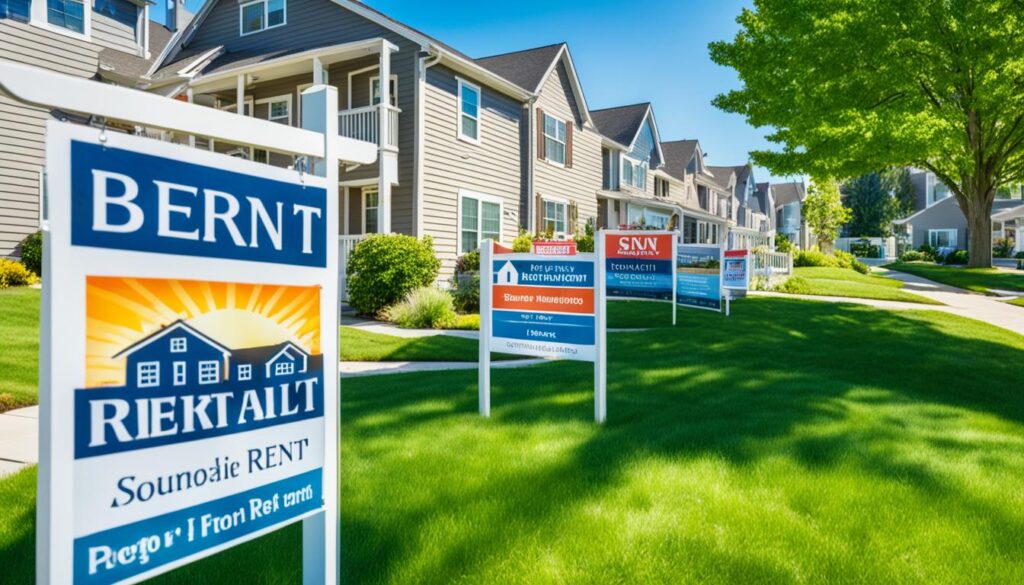Investing in real estate is a wise way to grow your wealth. It has benefits like diversification and tax advantages. The chance for regular income and increased value make it an appealing option. But with so many ways to invest, knowing which path to choose is key.
No single real estate investing strategy works for everyone. The right approach for you depends on your experience, how much control you want, and your goals for cash flow. Thinking about these areas helps you pick a strategy that boosts your profits and leads to wealth over time.
Key Takeaways:
- Investing in real estate offers diversification, tax breaks, cash flow, and appreciation potential.
- The best real estate investment strategy depends on your risk tolerance, control preferences, experience level, and cash flow goals.
- Understanding the property market and its dynamics is crucial for making informed investment decisions.
- Consider options like rental properties, house hacking, flipping, REITs, and property tax lien investing.
- Selecting the right strategy requires careful evaluation and aligning with your long-term financial objectives.
Invest in Single-Family Rental Properties
Single-family rental properties are becoming a top choice for real estate investors. They offer steady rental income and grow in value over the years. This makes them a smart investment.
Investors can earn money by renting these properties out. This income helps pay off the mortgage and cover maintenance costs. It also lets investors grow their wealth over time.
Another benefit is the option for fixed-rate mortgages. This locks in a set monthly payment, making financial planning easier. It also secures a low interest rate, increasing the return on investment.
These properties come with tax breaks too. Investors may enjoy deductions on expenses and depreciation. They can also defer capital gains tax, helping them keep more of their money.
Single-family homes are also a stable investment during economic ups and downs. They maintain their value, even in uncertain times. As inflation goes up, so can the rental prices, protecting the investor’s income.

The Advantages of Single-Family Rental Properties:
- Steady rental income helps cover mortgage payments and build equity
- Fixed-rate mortgages provide stability and predictable monthly payments
- Tax incentives optimize financial returns through deductions and exemptions
- Acts as a hedge against inflation, preserving the purchasing power of rental income
Choosing single-family homes for rental can lead to a reliable income source. With fixed-rate mortgages, tax benefits, and protection from inflation, they make for a sound investment. It’s crucial to research the market, review property values, and consider demand before jumping in.
| Advantages of Single-Family Rental Properties |
|---|
| Steady rental income |
| Fixed-rate mortgages |
| Tax incentives |
| Inflation hedge |
House Hacking
Want to lower your mortgage payments and make money on the side? House hacking is a great way to go. It involves living in part of a property and renting out the rest. This helps you earn rental income that can cover your mortgage and even bring in extra cash.
This approach is perfect for first-time real estate investors. You don’t need a big initial payment. Plus, you can use regular home loans.
“House hacking is a great way for beginners to learn about real estate. It’s low-risk and affordable.” – John Smith, Real Estate Investor
House hacking lets you decide how to maximize your rental income. You could rent out part of your home or buy a place with many units to rent those out. The rent you collect can pay most, if not all, of your mortgage.
By house hacking, investors cut down their living expenses. This frees up money for other investments or savings. Remember, being a landlord does come with duties.
Advantages of House Hacking:
- Reduced mortgage payments with rental income
- Opportunity to live for free or at a significantly lower cost
- Lower down payments and access to residential mortgages
- Potential for long-term property appreciation
- Build equity while living in your investment property
House hacking can help you on your journey to financial independence. With the right plan, it can cut your housing costs and grow your real estate assets.
Let’s look at an example to show why house hacking is so beneficial:
| House Hacking Scenario | Without House Hacking | With House Hacking |
|---|---|---|
| Monthly Mortgage Payment | $2,000 | $2,000 |
| Rental Income | $0 | $1,000 |
| Out-of-Pocket Housing Expense | $2,000 | $1,000 |
Note: The example shows a $2,000 mortgage payment. Without house hacking, it all comes from your pocket. But with house hacking, $1,000 from rent cuts your monthly cost to $1,000.
House hacking is a smart way to invest in real estate. It can lessen your mortgage burden, create extra income. Plus, it puts your financial future in your hands.

Flipping Properties
Flipping properties means buying homes that need work, fixing them up, and selling fast for more money. It’s a method mainly for investors who want to make a quick profit. They have to be smart to find good deals and know how to improve the houses without spending too much.
To succeed in property flipping, pick houses that will be worth a lot more after they’re fixed. These homes are often cheap because they’re not in good shape. When they’re fixed right, they become more valuable.
Selling quickly is the aim, to make as much money as possible. So, a good team is vital. This team includes contractors for the fixes, real estate agents for the selling, and home inspectors to check everything is okay.
There are obstacles in property flipping, like the higher taxes on profits made in less than a year. It’s something to think about because these taxes can eat into your earnings. Make sure the taxes fit in with your money plans before you start.
But, even with the challenges, property flipping can pay off big if you know what you’re doing. It can lead to a good amount of money quickly. So, for people who understand the real estate market and have the means, it’s a tempting choice.
Live-In Flip
Have you heard of the live-in flip strategy? It lets you upgrade a home while living in it. This method uses special loans like FHA or VA with low-interest rates for the home you plan to live in and fix up.
The idea is simple. Find a home that needs work and is priced below the market. Then, live there while you fix it up. This way, you save money on housing costs as you renovate.
After fixing it up, sell the home for more than you bought it. If you follow certain rules, the profit up to $250,000 ($500,000 for a couple) may be tax-free.
By living in the property while renovating it allows you to save money on housing expenses and maximize your profit potential when selling.
To succeed with this strategy, choose a home with a high-value potential after renovation. Pick one that needs mostly cosmetic changes. This ensures you don’t overspend but still raise its value.
Use upgrades that make your home more energy-efficient and attractive. Knowing what buyers in your area like is key. This will help you make choices that increase your home’s desirability.
Finding Financing Solutions for a Live-In Flip
For financing, consider FHA or VA loans. They come with good interest rates and terms. These options help lower the costs of buying and renovating a home you plan to live in.
FHA loans need a low down payment and are easier to qualify for. Plus, you can include renovation costs in the loan through the FHA 203(k) program.
VA loans are for eligible veterans and service members. They offer nice benefits like no down payment. You can use them for buying and renovating a fixer-upper too.
Get advice from a loan expert. They can help you choose the right loan for your live-in flip.
Benefits of a Live-In Flip
- Tax-Free Profit: Selling a primary residence that meets IRS criteria can result in tax-free profits up to $250,000 ($500,000 for married couples).
- Owner-Occupied Financing: FHA or VA loans offer favorable interest rates and terms for individuals planning to live in the property while renovating.
- Low Housing Costs: Living in the property during renovations helps save money on rent or mortgage payments.
- Customization: By living in the property during renovations, you have the opportunity to personalize it to your liking and potentially increase its market appeal.
Make sure to think through your budget and renovation plans for a live-in flip well. With the right research and planning, it can be a rewarding way to upgrade your home and make a tax-free profit.

Real Estate Wholesaling
Real estate wholesaling is an investment method that can be very profitable. It involves buying property at a low price and then selling it for more, acting as a middle person.
Successful wholesalers use various methods to find good deals. This includes physically looking for properties in poor conditions and sending offers directly to the owners.
To find good deals, successful real estate wholesalers employ a range of strategies, including driving for dollars and direct mail marketing. Driving for dollars involves physically visiting neighborhoods to identify distressed properties that show signs of neglect or distress. Once potential properties are identified, wholesalers initiate direct mail marketing campaigns to reach out to the owners and present their offers.
Direct mail marketing is a clever way to contact sellers looking to sell fast. With well-crafted messages, it’s possible to get the property owners interested. This can lead to a fast and successful sale.
Wholesalers must be good at judging the value of a property and its repair costs. Knowing these helps in getting the property at a good price. This strategy means they can make a profit when they sell the property to a buyer.
Real estate wholesaling is good for investors because they don’t need a lot of money upfront. They can sell the property quickly, avoiding the need for their own financing or long waits. This way, they make money without the effort of managing or fixing up the property.
Successful real estate wholesalers possess a keen eye for spotting lucrative deals, a strong marketing acumen, and exceptional negotiation skills. By acting as the middleman in real estate transactions, wholesalers can find opportunities that benefit both sellers and buyers and earn a profit in the process.
Yet, wholesaling comes with its own risks. It’s important to thoroughly check all deals to make sure there are no hidden problems. Also, having a good network of investors and buyers is key to making deals run smoothly.

| Key Elements of Real Estate Wholesaling | Benefits |
|---|---|
| Finding distressed or undervalued properties | Minimal upfront capital required |
| Negotiating favorable purchase prices | Speedy transactions without financing |
| Marketing to potential sellers | Income generation without property management |
| Assigning contracts to buyers | Opportunity to build a profitable network |
Real Estate Investment Trusts (REITs)
There are various ways to make passive income by investing in real estate. One top option is Real Estate Investment Trusts (REITs). They are companies enabling people to invest in real estate that produces income, without actually owning the properties.
When you invest in REITs by buying shares, you can enjoy the rental income from these properties. Plus, you’ll get regular dividends. It’s a simple way to invest in real estate without having to deal with property management.
REITs allow you to invest in a mix of real estate assets, from homes to commercial buildings and shopping centers. This blend lowers your risks and boosts the possibility of steady returns.
One big plus of REITs is that they let you access real estate income without needing a lot of money upfront. With a small starting cost, you can still enjoy a steady cash flow and the chance for bigger earnings down the road.
Besides easy access to income, REITs also provide the chance for your shares to increase in value over time. So not only can you get regular income, but you may also see your investment grow over the years.
Remember, by law, REITs must pay out at least 90% of their taxable income as dividends. This rule makes REITs a good choice for people who want to invest in stocks that pay out dependable dividends.
If you’re starting out in real estate investing or want to broaden your investment mix, REITs are a smart choice. They give you an easy way to invest in property for income and growth.
Advantages of Investing in REITs:
- Access to income-producing real estate without the need for direct ownership
- Diversification across various real estate asset types
- Opportunity for regular dividend income
- Potential for capital appreciation
- Lower entry point compared to direct property investments
Example REITs:
| REIT Name | Property Type | Dividend Yield |
|---|---|---|
| Simon Property Group | Retail | 4.2% |
| AvalonBay Communities | Residential | 2.9% |
| Prologis | Industrial | 2.7% |
| Duke Realty | Office | 2.5% |
These examples show a small part of the many REITs out there. Before deciding on any investment, it’s crucial to do intensive research. Look into the types of properties they invest in, past performance, and how much they pay in dividends.
You can buy REITs through a brokerage account. Make sure to talk to a financial advisor or a real estate pro. They can help you make choices that match your financial goals and the risks you’re willing to take.
Real Estate Investment Groups (REIGs)
REIGs, or real estate investment groups, are a great way to invest in real estate without much hassle. Investors join hands and money to buy property together. This means you can spread out your investments and don’t have to deal with managing the property.
REIGs work differently from REITs, traded on the stock market. You directly own a part of the properties in REIGs. This could offer more stable returns over time.
Members of a REIG often invest in rental properties. This method lets them buy and manage rentals together. It’s a good way to access more properties than you could on your own, spreading the risk.
The big draw of REIGs is how hands-off they are. You don’t have to worry about the everyday side of being a landlord. This is perfect for people who are too busy to deal with managing property.
REIGs also give you the chance to learn from others in the group. You get access to collective knowledge and experience. This can help you make better investment choices.
But, remember, investing in REIGs does have risks. You should do your homework before jumping in. Check the REIG’s history, see if they know what they’re doing, and figure out the costs.
Overall, REIGs are a smart, passive way to get into real estate. They offer a chance to blend your resources and knowledge with others. For anyone wanting to invest in real estate without the big hassle, REIGs might be the answer.
Advantages of Real Estate Investment Groups:
- Opportunity to diversify investment portfolio through pooled investments
- Passive investment strategy with reduced management responsibilities
- Access to physical real estate ownership
- Ability to leverage collective knowledge and expertise
Property Tax Lien Investing
Property tax lien investing is a special way to invest in real estate. It involves buying tax lien certificates from towns or cities when homeowners don’t pay their taxes. This can let investors earn interest and maybe even own the property if the taxes aren’t paid by the owner.
When homeowners fall behind on property taxes, it can be hard to catch up. This situation can be a good chance for investors. By buying these certificates, investors might make good money. And they’re often at lower risk than some other types of real estate investments.
Investing in tax liens starts with buying them at auctions or directly from the town. Once you have a certificate, you get the right to collect the overdue taxes. You can also get any extra fees or penalties that have piled up.
A big plus of this kind of investing is that it’s usually a safe bet. This is because the property itself secures the investment. If the homeowner doesn’t pay their taxes, you might be able to get the property. Then, you could sell it and maybe make a profit.
But, keep in mind, there are some risks with this type of investment. The property might have other debts or be in bad shape, needing more money to fix it. Also, not every certificate leads to owning the property. And the legal process can take time and be complex.
Benefits of Property Tax Lien Investing
This kind of investment can be great because:
- It can offer high interest rates that are better than what many other investments give.
- It’s a safe investment since the property stands as security.
- You might buy properties for a lot less if the owner can’t pay their taxes.
- It’s a different way to invest in real estate, adding variety to your portfolio.
Before you start, be sure to look into everything and understand all the rules. Know the local laws and the possible upsides and downsides. With the right research, this can be an exciting and rewarding investment.
| Pros | Cons |
|---|---|
| High yield potential | Risk of property foreclosure |
| Secured investment | Potential additional investment required |
| Potential for property acquisition | Lengthy and complex foreclosure process |
| Diversification of investment portfolio | Other liens on the property |
BRRR: Buy, Rehab, Rent, Refinance, Repeat
The BRRR strategy involves buying fixer-upper properties, fixing them up, renting them out, then refinancing to do it again. It’s becoming a favorite approach for real estate investors. It lets them slowly grow a long-term rental portfolio using short-term money or loans.
To start, investors look for fixer-upper properties sold below their real value. Usually, these places need a lot of work to become valuable. The aim is to buy low, add value through repairs, and make money immediately.
After buying, the next step is rehabbing. This means fixing what’s broken, improving features, and making the place look good to potential renters. The work also aims to make the property more valuable.
Now, it’s time to rent the property out. Finding good tenants and charging fair rent helps finance the investment. This money pays for the mortgage, taxes, and repairs. It also helps grow long-term wealth.
With the property rented out, investors can refinance. This means using the property’s increased value to get money. The extra cash can then buy new properties. This is how the BRRR cycle continues.
Over time, it’s wise to reduce borrowing and risks with lower leverage strategies. Managing a growing number of properties requires careful planning for long-term success.
BRRR lets investors make the most of their money. They do this by buying cheap, enhancing value, and earning from rent. This method also opens the door to better loans and tax perks from owning property.
In short, BRRR is a smart way to invest in real estate. It’s all about buying wisely, improving, renting, refinancing, and doing it again. Using short-term resources, investors can keep adding to their rental portfolio for future earnings.
Conclusion
Real estate investing lets you use different methods to grow your money, increase your profits, and make a fortune over time. You can do this by buying rental homes, using a technique called house hacking, selling homes quickly for more money, or by investing in REITs. The most important thing is to choose wisely based on what risks you’re okay with and what you want to achieve, considering your experience as well.
Real estate is a great way to earn money steadily. It also has tax benefits and its value can go up over time. When you put real estate into your money plan wisely, you can make a lot more cash and reach your financial dreams. This means picking the right ways to invest, ones that fit what you like and what you’re aiming for with your money. You might mix different methods to have a varied and smart real estate plan.
Starting to invest in real estate is just the beginning of a long process. It needs smart thought, good research, and always watching the market. Make sure to keep learning, talk to experts, and stay up-to-date. With a clear plan and being smart, real estate can really help you make a lot of money and gain the freedom you want.
FAQ
What are the best real estate investment strategies?
There are several winning ways to invest in real estate. These include single-family rentals, house hacking, and flipping properties for a quick profit. Other strategies are joining investing groups, dealing with property tax liens, and using a BRRR strategy. This strategy gives you a plan to buy, rehab, rent, refinance, and then do it again.
What is the advantage of investing in single-family rental properties?
Investing in single-family rental homes has many perks. You can earn money from renting them out. Plus, you get benefits from stable mortgage rates and tax breaks. This way, you can make a steady income and see the value of your property go up over time.
What is house hacking?
House hacking is about buying a home and renting a part of it out. You live in the other part. With this strategy, your rent can help pay your mortgage. It can also start making you money without much effort.
What is flipping properties?
Flipping properties means you buy homes that need work, fix them up, and sell them for more. This is a quick way to make a profit. To succeed, you need to find good deals, pick cost-efficient upgrades, and sell fast. But remember, you’ll pay more in taxes with short-term gains.
What is a live-in flip?
A live-in flip is buying a house that needs work and living in it as you fix it up. You can then sell it and not pay taxes on the profit. This works by using loans that are meant for people who will live in the home. It helps you keep more of the money you make.
What is real estate wholesaling?
Real estate wholesaling is when you find great deals and connect the seller with the buyer. To be good at it, you need to spot chances, negotiate well, and show the property to others in a way that makes them want to buy.
What are REITs?
REITs let you invest in real estate without owning it. They are like stocks for real estate. When you buy shares, you get a part of the profit from the rental income. It is an easy way to get into real estate and make money from it.
What are real estate investment groups (REIGs)?
Real estate investment groups let people join their money and knowledge to invest. Unlike REITs, they are more private and give you ownership of the actual buildings. This is good for those who want to invest in real estate without doing a lot of the work.
What is property tax lien investing?
Buying tax lien certificates is part of this strategy. It’s about getting these certificates when owners have not paid the property tax. If the owner doesn’t pay, you might be able to own the property through foreclosure. It can pay well, but it’s also risky.
What is BRRR investing?
BRRR investing is about buying homes, fixing them, renting them out, and then getting a new loan to do it again. This way, you can grow your real estate holdings. As you get more houses, it’s smart to be less risky with your loans and finances.
How can real estate investment strategies maximize returns and build lasting wealth?
Investing in real estate can bring money from rents, tax breaks, and the chance that your property value goes up. It’s key to pick a strategy that fits your goals and experience. This can help you make more money over time and grow your wealth.



















